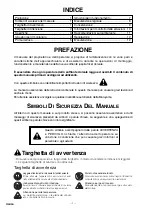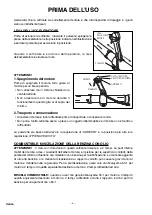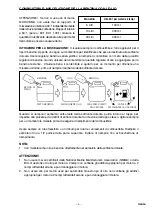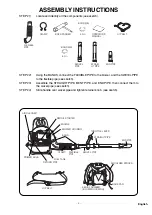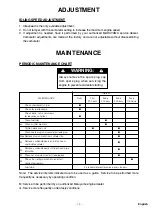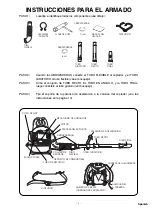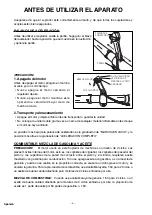
— 2 —
English
WARNING
1.
Read and understand this Owner's/Operator's Manual before using the power blower. Be thoroughly familiar with the
proper use of the power blower.
2.
Never allow children to operate the power blower. It is not a toy. Never allow adults to operate the unit without first
reading the Owner's / Operator's Manual.
3.
Become familiar with the controls and know how to stop the engine quickly.
4.
Always use eye protection and hearing protection.
5.
Keep the area of operation clear of all persons, particularly small children and pets.
6.
Do not point the blower nozzle in the direction of people or pets.
7.
Never operate a power blower when you are fatigued.
8.
Never operate a power blower without proper guards or other protective safety devices in place.
9.
Dress properly; do not wear loose clothing or jewelry that can be caught in moving parts. Always wear substantial
footwear, long pant, and long sleeved shirt.
10. Gasoline is highly flammable; handle it carefully.
A. Do not smoke while handling gasoline.
B. Use an approved fuel container for storing the gasoline/oil mixture.
C. Do not fill the fuel tank when the engine is hot or running
D. Fill the fuel tank outdoors and only up to one-half inch from the top of the tank. Do not fill the filler neck.
E. Wipe away any spilled gasoline before starting the engine.
11. Always be sure of your footing; keep a firm hold of the blower pipes, and walk, never run while operating a power
blower.
12. Use the correct accessories. Do not use the power blower for any job except that for which it is intended .
13. Keep all fasteners tight and be sure the power blower is in safe working condition. Follow the maintenance
instructions provided on page 10 - 12 of this manual.
14. Do not put hands or feet near or under the rotating parts. Keep clear at all times.
15. If the power blower should start to vibrate abnormally, stop the engine immediately and check for the cause. Vibration
is generally a warning of trouble.
16. Avoid using the power blower near rocks, gravel, stones and similar matter in order to avoid dangerous flying debris.
17. Use the power blower only in daylight or good artificial light.
18. Do not allow bystanders in work area.
19. Do not operate without guard(s) in place.
20. Do not operate in unventilated area.
21. To reduce the risk of injury associated with the inhalation of dust, use a face filter mask in dusty conditions.
22. To reduce the risk of injury associated with contacting rotating part, stop the engine before installing or removing
attachments.
23. To reduce the risk of fire and burn injury:
-Move at least 10ft (3m) away from the fueling point before starting engine.
-Always store gasoline in approved container.
Operating techniques
A.
Operate power equipment only at reasonable hours - not early in the morning or late at night when people might be
disturbed. Comply with times listed in local ordinances. Usual recommendations are 9:00 am. to 5:00 p.m., Monday
through Saturday.
B.
To reduce noise levels, limit the number of pieces of equipment used at any one time.
C.
To reduce noise levels, operate power blowers at the lowest possible throttle speed to do the job.
D.
Check your equipment before operation, especially the muffler, air intakes, and air filters.
E.
Use rakes and brooms to loosen debris before blowing.
F.
In dusty conditions, slightly dampen surfaces when water is available.
G.
Conserve water by using power blowers instead of hoses for many lawn and garden applications, including areas
such as gutters, screens, patios, grills, porches, and gardens.
H.
Watch out for children, pets, open windows, or freshly washed cars, and blow debris safely away.
I.
Use the full blower nozzle extension so the air stream can work close to the ground.
J.
After using blowers and other equipment, CLEAN UP! Dispose of debris in trash receptacles.
PURPOSE OF USE
Use of this product is cleaning of the garbage such as outdoor dead leaves, turf, a baseball field, a
park and a road.


